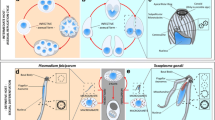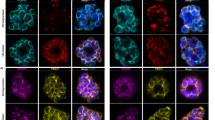Summary
Apicoplasts (apicomplexan plastids) are nonphotosynthetic, secondary endosymbiotic plastids that are found in most apicomplexans. Although these organelles are essential for parasite survival, their functions, activities, and structures are not well understood. We examined the apicoplast nucleoid ofToxoplasma gondii from a morphological aspect by high-resolution epifluorescence microscopy and electron microscopy. We found unexpectedly large amounts of DNA in the nucleoid and the presence of several division-related structures. Initially, we identified the organellar nucleoids by staining with the DNA-specific dye 4′,6-diamidino-2-phenylindole. A single nucleoid was observed per apicoplast, and the fluorescent spot representing the nucleoid was bright and spherical in contrast to the weak and filamentous spot representing the mitochondrial nucleoid. We also measured the DNA content of each apicoplast nucleoid by a video-intensified microscope photon-counting system and determined that the genomic copy number was at least 25, a figure over four times greater than that reported previously. Moreover, several groups of apicoplasts had significantly higher genomic copy numbers. The DNA molecules were accurately divided into two daughter apicoplasts just before nuclear division. In addition, we examined nucleoid segregation and the division apparatus using electron microscopy. However, we failed to observe nucleoid structures, suggesting that the apicoplasts are predominantly composed of nucleoid material. In addition, we observed “cap” structures at the termini of dividing apicoplasts, a possible plastid-dividing ring, and a microbody-like granule around the constriction. These structures may be involved in apicoplast division.
Similar content being viewed by others
Abbreviations
- DAPI:
-
4′,6-diamidino-2-phenylindole
- VIMPCS:
-
video-intensified microscope photon counting system
- PD:
-
ring plastid-dividing ring
References
Beech PL, Gilson PR (2000) FtsZ and organelle division in protists. Protist 151: 11–16
Birky CW Jr (1983) Relaxed cellular controls and organelle heredity. Science 222: 468–475
Blanchard JL, Hicks JS (1999) The non-photosynthetic plastid in malarial parasites and other apicomplexans is derived from outside the green plastid lineage. J Eukaryot Microbiol 46: 367–375
Coleman AW, Nerozzi AM (1999) Temporal and spatial coordination of cells with their plastid component. Int Rev Cytol 193: 125–164
Creasey A, Mendis K, Carlton J, Williamson DH, Wilson I, Carter R (1994) Maternal inheritance of extrachromosomal DNA in malaria parasites. Mol Biochem Parasitol 65: 95–98
Dexhelet GA, Coene MM, Hoet PP, Cocito CG (1989) Spectrofluorometry of dyes with DNAs of different base composition and conformation. Anal Biochem 179: 401–403
Ding M, Clayton C, Soldati D (2000)Toxoplasma gondii catalase: are there peroxisomes inToxoplasma? J Cell Sci 113: 2409–2419
Fichera ME, Roos DS (1997) A plastid organelle as a drug target in apicomplexan parasites. Nature 390: 407–409
Gardner MJ, Williamson DH, Wilson RJM (1991) A circular DNA in malaria parasites encodes an RNA polymerase like that of prokaryotes and chloroplasts. Mol Biochem Parasitol 44: 115–124
Gillham NW (1994) Organelle genes and genomes. Oxford University Press, New York, pp 110–126
Hashimoto H (1986) Double-ring structure around the constricting neck of dividing plastids ofAvena sativa. Protoplasma 135: 166–172
— (1997) Electron-opaque annular structure girdling the constricting isthmus of the dividing chloroplasts ofHeterosigma akashiwo (Raphydophyceae, Chromophyta). Protoplasma 197: 210–216
Hopkins J, Fowler R, Krishna S, Wilson I, Mitchell G, Bannister L (1999) The plastid inPlasmodium falciparum asexual blood stages: a three-dimensional ultrastructural analysis. Protist 150: 283–295
Johnson AM, Dubey JP, Dame JB (1986) Purification and characterization ofToxoplasma gondii tachyzoite DNA. Aust J Exp Biol Med Sci 64: 351–355
Kaasch AJ, Joiner KA (2000) Targeting and subcellular localization ofToxoplasma gondii catalase. J Biol Chem 275: 1112–1118
Köhler S, Delwiche CF, Denny PW, Tilney LG, Webster P, Wilson RJM, Palmer JD, Roos DS (1997) A plastid of probable green algal origin in apicomplexan parasites. Science 275: 1485–1489
Komaki K, Ishikawa H (2000) Genomic copy number of intracellular bacterial symbionts of aphids varies in response to developmental stage and morph of their host. Insect Biochem Mol Biol 30: 253–258
Kuroiwa T, Miyakawa S, Kawano S, Hizume M, Toh-E A, Miyakawa I, Sando N (1986) Cytological characterization of NOR in the bivalent ofSaccharomyces cerevisiae. Exp Cell Res 165: 199–206
—, Kawano S, Watanabe M, Hori T (1991) Preferential digestion of chloroplast DNA in male gametangia during the late stage of gametogenesis in the anisogamous algaBryopsis maxima. Protoplasma 163: 102–113
—, Fujie M, Kuroiwa H (1992) Studies on the behavior of mitochondrial DNA: synthesis of mitochondrial DNA occurs actively in a specific region just above the quiescent center in the root meristem ofPelargonium zonale. J Cell Sci 101: 483–493
—, Kuroiwa H, Sakai A, Takahashi H, Toda K, Itoh R (1998) The division apparatus of plastids and mitochondria. Int Rev Cytol 181: 1–41
Levine ND (1988) The protozoan phylumApicomplexa. CRC Press, Boca Raton, Fla
Maguire MJ, Goff LJ, Coleman AW (1995) In situ plastid and mitochondrial DNA determination: implication of the observed minimal plastid genome number. Am J Bot 82: 1496–1506
McConkey GA, Rogers MJ, McCutchan TF (1997) Inhibition ofPlasmodium falciparum protein synthesis: targeting the plastid-like organelle with thiostrepton. J Biol Chem 272: 2046–2049
McFadden GI, Roos DS (1999) Apicomplexan plastids as drug targets. Trends Microbiol 7: 328–333
—, Reith ME, Munholland J, Lang-Unnasch N (1996) Plastid in human parasites. Nature 381: 482
—, Waller RF, Reith ME, Lang-Unnasch N (1997) Plastids in apicomplexan parasites. In: Bhattacharya D (ed) Origins of algae and their plastids. Springer, Wien New York, pp 261–287 (Plant systematics and evolution suppl 11)
Mita T, Kanbe T, Tanaka K, Kuroiwa T (1986) A ring structure around the dividing plane of theCyanidium caldarium chloroplast. Protoplasma 130: 211–213
Miyagishima S, Itoh R, Toda K, Kuroiwa H, Nishimura M, Kuroiwa T (1999) Microbody proliferation and segregation cycle in the single-microbody algaCyanidioschyzon merolae. Planta 208: 326–336
Muller HJ (1964) The relation of recombination to mutational advance. Mutat Res 1: 2–9
Nakano T, Sato F, Yamada Y (1993) Analysis of nucleoid-proteins in tobacco chloroplasts. Plant Cell Physiol 34: 873–880
Palmer JD (1992) Green ancestry of malarial parasites? Curr Biol 2: 318–320
Siddall ME (1992) Hohlzylinders. Parasitol Today 8: 90–91
Smeijsters LJJW, Zijlstra NM, de Vries E, Franssen FFJ, Janse CJ, Overdulve JP (1994) The effect of (S)-9-(3-hydroxy-2-phosphonylmethoxypropyl)adenine on nuclear and organellar DNA synthesis in erythrocytic schizogony in malaria. Mol Biochem Parasitol 67: 115–124
Striepen B, Crawford MJ, Shaw MK, Tilney LG, Seeber F, Roos DS (2000) The plastid ofToxoplasma gondii is divided by association with the centrosomes. J Cell Biol 151: 1423–1434
Vaidya AB, Akella R, Suplick K (1989) Sequences similar to genes for two mitochondrial proteins and portions of ribosomal RNA in tandemly arrayed 6-kilobase-pair DNA of a malarial parasite. Mol Biochem Parasitol 35: 97–108
Waller RF, Keeling PJ, Donald RGK, Striepen B, Handman E, LangUnnasch N, Cowman AF, Besra GS, Roos DS, McFadden GI (1998) Nuclear-encoded proteins target to the plastid inToxoplasma gondii andPlasmodium falciparum. Proc Natl Acad Sci USA 95: 12352–12357
Williamson DH, Garner MJ, Preiser P, Moore DJ, Rangachari K, Wilson RJM (1994) The evolutionary origin of the 35 kb circular DNA ofPlasmodium falciparum: new evidence supports a possible rhodophyte ancestry. Mol Gen Genet 243: 249–252
Wilson RJM, Denny PW, Preiser PR, Rangachari K, Roberts K, Roy A, Whyte A, Strath M, Moore DJ, Moore PW, Williamson DH (1996) Complete gene map of the plastid-like DNA of the malaria parasitePlasmodium falciparum. J Mol Biol 261: 155–172
Wu H, Liu XQ (1997) DNA binding and bending by a chloroplast-encoded HU-like protein overexpressed inEscherichia coli. Plant Mol Biol 34: 339–343
Author information
Authors and Affiliations
Rights and permissions
About this article
Cite this article
Matsuzaki, M., Kikuchi, T., Kita, K. et al. Large amounts of apicoplast nucleoid DNA and its segregation inToxoplasma gondii . Protoplasma 218, 180–191 (2001). https://doi.org/10.1007/BF01306607
Received:
Accepted:
Issue Date:
DOI: https://doi.org/10.1007/BF01306607




